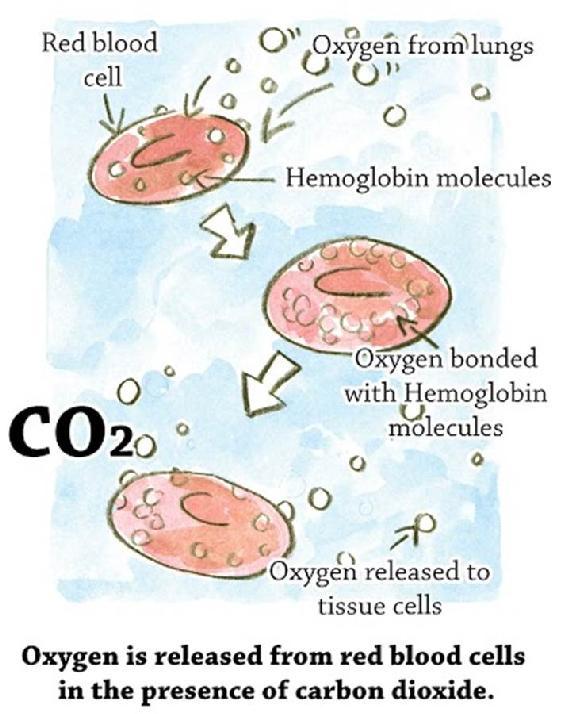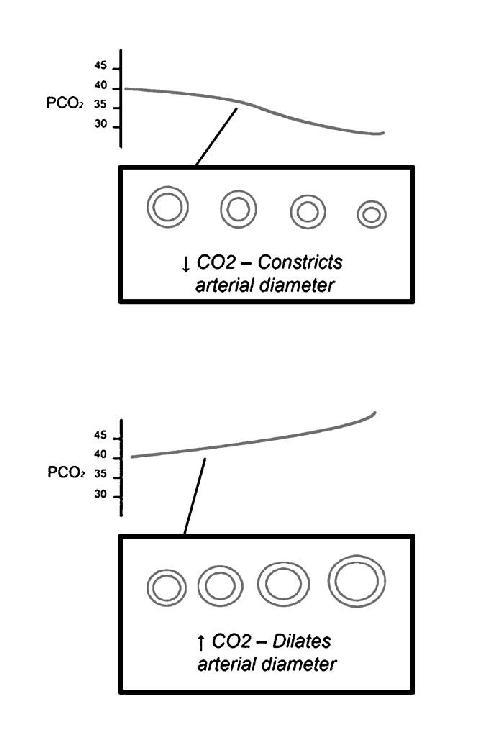 or normal, healthy functioning, the body requires a certain amount of both oxygen and carbon dioxide. It is widely recognized that oxygen is a gas essential to life, but many people are surprised to hear that carbon dioxide is not just a waste gas. In terms of breathing, the two work hand in hand.
or normal, healthy functioning, the body requires a certain amount of both oxygen and carbon dioxide. It is widely recognized that oxygen is a gas essential to life, but many people are surprised to hear that carbon dioxide is not just a waste gas. In terms of breathing, the two work hand in hand.
When we take a breath of fresh air into our lungs, oxygen passes from the lungs to the blood where it is picked up and carried through the blood vessels by a molecule called hemoglobin. This oxygen-rich blood is then pumped by the heart throughout the body so that oxygen can be offloaded to cells for conversion to energy. In order to release oxygen from the blood, however, hemoglobin requires a catalyst, which involves an increase in body temperature and the presence of carbon dioxide (CO2 ).
Physical exercise is a perfect example of these conditions: when we move our muscles, the body requires more oxygen to give us energy and perform at a higher intensity. During exercise, body temperature increases and cells produce carbon dioxide, allowing extra oxygen to be released by the blood to the muscles and organs.
The concentration of carbon dioxide in the blood is determined by our breathing. The habit of breathing in excess of bodily requirements causes too much carbon dioxide to be exhaled from the lungs, which in turn causes a reduction of the concentration of CO2 in the blood. When carbon dioxide levels are less than adequate, the transfer of oxygen from blood to muscles and organs is limited, leading to poor body oxygenation.
This necessary presence of carbon dioxide was discovered in 1904 by the physiologist and Nobel laureate Christian Bohr, who recognized that CO2 affects the release of oxygen from the blood to tissues and organs.

According to the Bohr Effect, when there is an increased pressure of carbon dioxide in the blood, pH drops and oxygen is released more readily. Conversely, when carbon dioxide levels are low, hemoglobin molecules are less able to release oxygen from the blood. The way we breathe determines the amount of carbon dioxide present in our blood, and therefore how well our bodies are oxygenated.
Another function of carbon dioxide is that it relaxes the smooth muscle embedded in airways, arteries and capillaries, enabling smooth breathing and healthy blood flow. For those genetically predisposed to asthma, the loss of CO2 caused by over-breathing leads to constriction of the airways. By breathing calmly and quietly, you will retain healthy levels of carbon dioxide and your blood vessels and airways will remain open and clear.
Carbon dioxide has profound effects on blood flow. An increase of carbon dioxide causes an opening of the blood vessels and increased blood flow, whereas a decrease to carbon dioxide causes constriction of the blood vessels and decreased blood flow.
Constriction of the blood vessels in response to breathing too much air can reduce the amount of oxygen available to the brain by 50%.1 For example, in humans 5% inhalation of carbon dioxide increases blood flow supplying the brain by 50% and 7% inhalation of carbon dioxide causes a 100% increase in blood flow.1 It is no coincidence that symptoms like fatigue, anxiety and poor concentration are so common nowadays, even amongst athletes – chronic over-breathing contributes to all these issues.

So how do we ensure that we take in enough carbon dioxide? The solution is clearly not to breathe more! We cannot inhale carbon dioxide from the atmosphere; it is a by-product of metabolic chemical reactions within the body. And while it is true that carbon dioxide can be classed as a waste gas, we only exhale CO2 to get rid of the excess – it is vital that a certain amount of carbon dioxide is retained in the blood for healthy body function.
Breathing too much can very easily become a habit. Modern living, poor diet, stress, and a lack of exercise all contribute to resetting the breathing center in the brain so that it becomes less tolerant to carbon dioxide. With a low tolerance to carbon dioxide, breathing volume will continue to be larger than normal. Chronic over-breathing also results in the constriction of blood vessels and a reduction in the amount of oxygen delivered to the cells, leading to excessive breathlessness and poor exercise tolerance.
Carbon dioxide is produced through the body’s metabolism – when oxygen meets with the food we eat to create energy, carbon dioxide is generated. There are only two ways to increase the amount of carbon dioxide in the body:
· By practicing breathing exercises to gently reduce the amount of air we breathe
· By increasing metabolic activity through physical exercise
While exercise is beneficial, it is vitally important not to breathe too much during physical activity, otherwise your efforts will be counterproductive. Practicing the Reduced Breathing exercise (link ) will also increase the body’s tolerance to carbon dioxide, and should be reflected in a steady improvement to your Control Pause from week to week.
By taking less air into the lungs during rest or physical exercise, carbon dioxide is able to accumulate in the blood. After just ten minutes, the part of the brain that regulates breathing volume can be reset to tolerate a greater amount of carbon dioxide. By reducing breathing volume towards normal, blood vessels and airways dilate, and oxygen is more readily released from the red blood cells. Each time you practice Reduced Breathing exercises and reset your breathing volume, you are one step closer to a permanent change to optimal breathing patterns.